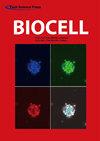高血糖诱导的心肌纤维化可能与糖尿病小鼠心肌细胞的焦亡和凋亡有关
IF 1
4区 生物学
Q4 BIOLOGY
引用次数: 0
摘要
心肌纤维化是糖尿病性心肌病的重要表现。本研究探讨糖尿病心肌纤维化的潜在机制。8周龄雄性C57BL/6J和db/db小鼠随机分为糖尿病(db)组和对照组。20周时,采集小鼠心脏,进行苏木精-伊红染色(HE)和Masson染色,观察纤维化程度。western blotting检测转化生长因子-β1 (TGF-β1)、胶原- iii、b细胞淋巴瘤-2 (Bcl2)、Bcl2相关X蛋白(Bax)、裂解气皮蛋白D (GSDMD)、半胱氨酸天冬氨酸特异性蛋白酶-1 (caspase-1)、凋亡相关含CARD斑点样蛋白(ASC)、核苷酸结合寡聚结构域(NOD)样受体3 (NLRP3)的表达。采用免疫组织化学和tdt介导的dUTP缺口末端标记(TUNEL)染色分析细胞凋亡和焦亡的发生。观察到DB组体重和血糖显著增加。DB组心肌病理损伤、纤维化、凋亡、焦亡更为明显和严重。DB组抗凋亡Bcl2表达显著降低,促凋亡Bax、caspase-3及裂解型GSDMD、caspase-1等凋亡相关蛋白表达水平显著升高。焦亡和细胞凋亡可能是引起糖尿病小鼠心肌纤维化的主要机制。本文章由计算机程序翻译,如有差异,请以英文原文为准。
Hyperglycemia-induced myocardial fibrosis may be associated with pyroptosis and apoptosis of cardiomyoctes in diabetic mice
Myocardial fibrosis is an important manifestation of diabetic cardiomyopathy. This study investigated the potential mechanism of diabetic myocardial fibrosis. Male C57BL/6J and db/db mice aged 8 weeks were randomly divided into the diabetic (DB) and control groups. At 20 weeks, the mouse heart was harvested and subjected to hematoxylin-eosin staining (HE) and Masson staining to investigate the degree of fibrosis. The expressions of transforming growth factor-beta 1 (TGF-β1), collagen-III, B-cell lymphoma-2 (Bcl2), Bcl2-associated X protein (Bax), cleaved gasdermin D (GSDMD), cysteinyl aspartate specific proteinase-1 (caspase-1), apoptosis-associated speck-like protein containing a CARD (ASC), and nucleotide-binding oligomerization domain (NOD)-like receptor 3 (NLRP3) were measured by western blotting. Immunohistochemistry and TdT-mediated dUTP nick end labeling (TUNEL) staining were performed to analyze the development of apoptosis and pyroptosis. A significant increase in body weight and blood glucose in the DB group was observed. Myocardial pathological injury, fibrosis, apoptosis, and pyroptosis were more obvious and serious in the DB group. The expression of anti-apoptotic Bcl2 significantly decreased, while the expression levels of pro-apoptotic Bax, caspase-3, and pyroptosis-related proteins, such as cleaved GSDMD, and caspase-1 in the DB group were significantly increased. Pyroptosis and apoptosis were probably the main mechanisms that caused myocardial fibrosis in mice with diabetes.
求助全文
通过发布文献求助,成功后即可免费获取论文全文。
去求助
来源期刊

Biocell
生物-生物学
CiteScore
1.50
自引率
16.70%
发文量
259
审稿时长
>12 weeks
期刊介绍:
BIOCELL welcomes Research articles and Review papers on structure, function and macromolecular organization of cells and cell components, focusing on cellular dynamics, motility and differentiation, particularly if related to cellular biochemistry, molecular biology, immunology, neurobiology, and on the suborganismal and organismal aspects of Vertebrate Reproduction and Development, Invertebrate Biology and Plant Biology.
 求助内容:
求助内容: 应助结果提醒方式:
应助结果提醒方式:


